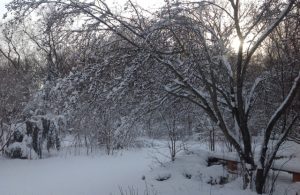
Damage to plants and trees may not be evident until spring thaw.
Photo Credit: Rosie Lerner / Purdue Horticulture
When winter temperatures dip below zero and winds howl across the prairie, gardeners may worry that their trees and shrubs are taking a beating. No need for doom and gloom yet – most hardy landscape and orchard plants are reasonably able to cope with most of our winters, including our recent polar vortex.
Many factors influence plant injury, including plant species and cultivars, degree of plant dormancy and overall plant health. How low the temperature goes, how long it stays there and how well acclimated plants are at the time are additional factors.
Much of Indiana spent two or three days with subzero temperatures and high winds. While it is too soon to know how much damage to expect, the good news is that plants were fully dormant prior to this episode. Snow cover is a big help, too, providing considerable insulation.
The severe lows coupled with high winds may cause some dieback of twigs and winter burn on ornamentals, especially evergreens. Broad-leaved evergreens are the most susceptible. Winter dessication injury occurs when absorption of water by the roots cannot keep up with moisture lost by the foliage (transpiration). This occurs mainly on sunny days, especially if it is windy and the soil water is frozen – the plant can’t absorb it – or if water is in short supply. Injury appears as brown leaf margins or needletips at the onset of warm weather.
Generally, flower buds are more sensitive to cold than leaf buds, so flower buds on some fruit trees such as peaches, nectarines and sweet cherries could have been damaged. However, it is very likely than some flower buds will survive, enough for at least a partial crop. Blackberries, blueberries and grapes may also have significant bud loss, particularly on more tender cultivars. Species that are marginally hardy will likely suffer dieback, or possibly death, but this may not be obvious until spring thaw. You might want to delay major pruning until after winter damage can be assessed.
There is still plenty more winter to endure before we will know the status of our plants. There’s not anything you can do to control the weather, so stay safe and warm and dream of warmer days to come!